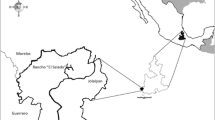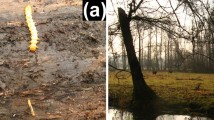Abstract
We studied Coleoptera emerging from deadwood in a broadleaved forest that has been managed with nature-oriented forestry since 1990 and in which an accumulation of 10 m3 deadwood/ha has been achieved. We sampled a total of 11 m3 of deadwood from oak and beech trees and yielded 32,477 individuals pertaining to 342 species. The number of species emerging from oak deadwood was significantly higher than that from beech. Significantly more species emerged from deadwood with medium size (15–21 cm) diameter than from smaller (5–7 cm) or larger (40–60 cm) diameters. The stage of decay did not influence the number of species during the first 6 years of decomposition. Species richness strongly increased with the amount of deadwood sampled. Species–area regressions yielded z-values of 0.81 for oak and 0.87 for beech deadwood. The beetle assemblage was characterized by a low number of xylophagous species and a high number of mobile zoophagous species. However, two-thirds of the individuals sampled pertained to nine species of Scolytidae. This is why Shannon–Wiener diversity (H) and evenness-indices (E) greatly decreased with increasing number of scolytids. The species and individuals yielded from the sun-exposed deadwood outnumbered those from shaded areas. Namely the scolytid Taphrorychus bicolor reached remarkably high densities in the sun-exposed beech deadwood (>800 individuals/m2). In contrast, oak deadwood never harboured such high numbers of scolytids. Felling of moribund trees had decreased the number of scolytids but it had also considerably reduced the number of rare and endangered species.
Similar content being viewed by others
References
Ammer U. 1991. Konsequenzen aus den Ergebnissen der Totholzforschung für die forstliche Praxis. Forstwissenschaftliches Centralblatt 110: 149–157.
Bengtsson J., Nilsson S.G., Franc A. and Menozzi P. 2000. Biodiversity, disturbances, ecosystem function and management of European forests. Forest Ecology and Management 132: 39–50.
Ecke F., Löfgren O. and Sörlin D. 2002. Population dynamics of small mammals in relation to forest age and structural habitat factors in northern Sweden. Journal of Applied Ecology 39:781–792.
Freude H., Harde K. and Lohse G.A. 1964-1994. Die Käfer Mitteleuropas. Vol. 1-14. Goecke and Evers, Krefeld, Germany.
Funke W. 1971. Food and energy turnover of leaf-eating insects and their influence on primary production. Ecological Studies 2: 81–93.
Grove S.J. 2002. Saproxylic insect ecology and the sustainable management of forests. Annual Review of Ecology and Systematics 33: 1–23.
Haase V. 1997. Xylobionte Insekten im Eichen-Totholz eines Wirtschaftswaldes. Diploma-Thesis, University of Cologne, Germany.
Haase V., Topp W. and Zach P. 1998. Eichen-Totholz im Wirtschaftswald als Lebensraum für xylobionte Insekten. Zeitschrift für Ökologie und Naturschutz 7: 137–153.
Harmon M.E., Franklin J.F., Swanson F.J., Sollins P., Gregory S.V., Lattin J.D. et al. 1986. Ecology of coarse woody debris in temperate forests. Advances in Ecological Research15: 133–302.
Harz B. 1998. Besiedlung von Buchen-und Eichentotholz durch Insekten in Abhängigkeit von der Insolation. Diploma-Thesis, University of Cologne, Germany.
Harz B. and Topp W. 1999. Totholz im Wirtschaftswald: eine Gefahrenquelle zur Massenvermehrung von Schadinsekten? Forstwissenschaftliches Centralblatt 118: 302–313.
Irmler U., Heller K. and Warning J. 1996. Age and tree species as factors influencing the populations of insects living in dead wood. Pedobiologia 40: 134–148.
Jonsell M., Weslien J. and Ehnström B. 1998. Substrate requirements of Red-listed saproxylic invertebrates in Sweden. Biodiversity and Conservation 7: 749–764.
Jonsson B.G. and Jonsell M. 1999. Exploring biodiversity indicators in boreal forests. Biodiversity and Conservation 8: 1417–1433.
Kennedy C.E.J. and Southwood T.R.E. 1984. The number of species of insects associated with Britishtrees: a re-analysis. Journal of Animal Ecology 53: 455–478.
Kleinevoss K. 1995. Buchen-Totholz im Wirtschaftswald als Lebensraum für saproxylische Insekten. Diploma-Thesis, University of Cologne, Germany.
Kleinevoss K., Topp W. and Bohac J. 1996. Buchen-Totholz im Wirtschaftswald als Lebensraum für xylobionte Insekten. Zeitschrift für Ökologie und Naturschutz 2: 85–95.
Köhler F. 2000. Totholzkäfer in Naturwaldzellen des närdlichen Rheinlands. Schriftenreihe der LÖBF 18: 1–352.
Känig R. 2001. Vertikale Zonierung von xylobionten Insekten in einem naturnahen Wirtschaftswald. Diploma-Thesis, University of Cologne, Germany.
Korpel S. 1995. Die Urwälder der Westkaparten. Fischer, Stuttgart, Germany, 310 pp.
Korpel S. 1997. Totholz in Naturwäldern und Konsequenzen für die Forstwirtschaft. Forst und Holz 52: 619–624.
McMinn J.W. and Crossley D.A. (eds) 1996. Biodiversity and coarse woody debris in southern forests. Proceedings of the Workshop on Coarse Woody Debris in Southern Forests: Effects on Biodiversity. Athens, Georgia, 18-20 October 1993, USDA Forest Service, Asheville, North Carolina, 146 pp.
Mountford E.P. 2002. Fallen dead wood levels in the near-natural beech forest at La Tillaie reserve, Fontainebleu, France. Forestry 75: 203–208.
Nilsson S.G. and Baranowski R. 1997. Habitat predictability and the occurrence of wood beetles in old-growthbeechforests. Ecography 20: 491–498.
Økland B., Bakke A., Hågvar S. and Kvamme T. 1996. What factors influence the diversity of saproxylic beetles? A multiscaled study from a spruce forest in southern Norway. Biodiversity and Conservation 5: 75–100.
Paine T.D., BirchM.C. and Švihra P. 1981. Niche breadth and resource partitioning by four sympatric species of bark beetles (Coleoptera, Scolytidae). Oecologia 48: 1–6.
Raffa K.F. and Berryman A.A. 1983. The role of host plant resistance in the colonization behavior and ecology of bark beetles (Coleoptera: Scolytidae). Ecological Monographs 53: 27–49.
Reeve J.D. 1997. Predation and bark beetle dynamics. Oecologia 112: 48–54.
Rinn F. 1994. Bohrwiderstandsmessungen mit Resistograph-Mikrobohrungen. Allgemeine Forstzeitschrift 12: 650–654.
Rosenzweig M.L. 1995. Species Diversity in Space and Time. Cambridge University Press, Cambridge, UK.
Sachs L. 1992. Angewandte Statistik. 7th edn. Springer, Berlin, Germany.
Schiegg K. 2000. Are there saproxylic beetle species characteristic of high dead wood connectivity? Ecography 23: 579–587.
Schiegg K. 2001. Saproxylic insect diversity of beech: limbs are richer than trunks. Forest Ecology and Management 149: 295–304.
Sch00F6nherr J. and Krautwurst K. 1979. Beobachtungen über den Buchenborkenkäfer Taphrorychus bicolor (Col., Scolytidae). Anzeiger für Schädlingskunde, Pflanzenschutz, Umweltschutz 52: 161–163.
Schwenke W. 1974. Die Forstschädlinge Europas. Vol. 2. Verlag Paul Parey, Hamburg, Germany.
Schwenke W. 1994. Über die Grundlagen der Entstehung und Begegnung von Insekten-Massenvermehrungen im Wald. Anzeiger für Schädlingskunde, Pflanzenschutz, Umweltschutz 67: 120–124.
Sippola A.-L., Siitonen J. and Punttila P. 2002. Beetle diversity in timberline forests: a comparison between old-growthand regeneration areas in FinnishLapland. Annales Zoologici Fennici 39: 69–86.
Southwood T.R.E. and Kennedy C.E.J. 1983. Trees as islands. Oikos 41: 359–371.
Zach P., Topp W., Kuflan J. and Simon M. 2001. Colonization of two alien ambrosia beetles (Coleoptera, Scolytidae) on debarked spruce logs. Biologia (Bratislava) 56: 175–181.
Rights and permissions
About this article
Cite this article
Kappes, H., Topp, W. Emergence of Coleoptera from deadwood in a managed broadleaved forest in central Europe. Biodiversity and Conservation 13, 1905–1924 (2004). https://doi.org/10.1023/B:BIOC.0000035873.56001.7d
Issue Date:
DOI: https://doi.org/10.1023/B:BIOC.0000035873.56001.7d




